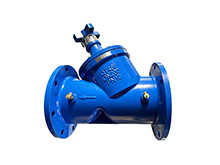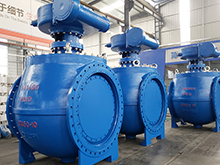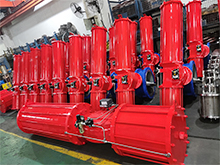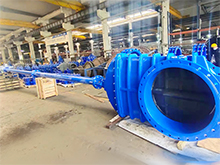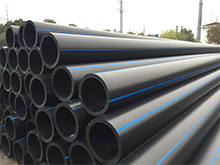- Gate valve
-
- DN1000 Extension stem double flange soft seal gate valveDIN F4 resilient seated gate valveDN450-1200 Resilient Seated Gate ValveDIN F5 resilient seated gate valveSocket connection soft seal gate valveUnderground cap soft seal gate valveBS5163 rising stem soft seal gate valveHard seal gate valveAPI slab Gate ValveStainless steel flange gate valveWafer knife gate valvePneumatic gate valveSoft seal gate valveExtension stem gate valveUL/FM fire protection groove ends gate valveRising stem forged steel gate valvecarbon steel gate valveStainless steel threaded gate valveDIN soft seal gate valveANSI soft sealing gate valve 200PSICast iron gate valveBS resilient seated gate valve
- Butterfly valve
-
- DN900 pneumatic triple eccentric hard seal butterfly valveD643H Triple Eccentric Butterfly ValveD343H Hard seal butterfly valveMulti standard EPDM seated butterfly valveSingle flange butterfly valveDN2000 Double eccentric butterfly valveFlange butterfly valveLug butterfly valveWafer butterfly valve with handleWorm gear operated butterfly valveWafer lined fluorine butterfly valveStainless steel wafer butterfly valveStainless steel flanged butterfly valveThree eccentric flange butterfly valvePneumatic flanged butterfly valvePneumatic wafer butterfly valveTriple eccentric butterfly valve wafer typeWafer butterfly valve ULC approvedInflatable seat butterfly valveHigh performance butterfly valveGrooved end butterfly valveElectric soft seal butterfly valveFlange fluorine lined butterfly valveHandle aluminum butterfly valveWorm Gear Aluminum Butterfly ValveFull PTFE lined butterfly valve wafer typeOne stem no-pin wafer butterfly valveMulti standard aluminum stem butterfly valveStainless Steel wafer Butterfly ValveAluminium handle operated lug butterfly valveLever Operated Flange Butterfly ValveButterfly valve stemButterfly valve discButterfly valve seat
- Ball valve
-
- DN1400 top-mounted eccentric semi-ball valveFlanged three-way ball valveFully welded ball valveNatural gas ball valveHigh platform flange ball valve1 PC ball valveFixed ball valvePTFE seat flanged ball valveMetal seat ball valveAPI 6D ball valve3 Piece ball valveFull Bore 3 way ball valve L-Port3 Way T-Port ball valve2PC Ball valve female thread stainless steel
- Globe Valve
-
- API Carbon Steel Globe ValveBellows Globe ValveStainless steel flange globe valveStainless steel thread S type globe valveStainless steel thread B type globe valveCast Steel Globe ValvePiston Globe ValveWCB Carbon Steel Globe Check Valveelectric motorized control stainless steel SS316 globe valveBrass Globe ValveCryogenic Globe valveHT200 Globe ValveThreaded Stainless Steel Globe ValveGG25 Globe ValveANSI API Cast Steel And Stainless Steel Globe valve
- Check valve
-
- Rubber seal check valveDN800 Slow closing check valveDN800 Rubber Disc Check ValveButterfly Buffering Check Valvecheck valve with counter weightSilent Check ValveWCB Swing check valveSwing Check ValveSingle Chip Check Valve H74WStainless Steel Wafer Check ValveSwing Start Check ValveFoot check valveAPI Swing Check ValveDIN Flange check valveSingle plate check valveLifting Check ValveBottom ValveHammer Diminish Noises Check ValveWafer Check ValveWafer dual plate check valve
- Control valve
-
- Static Balancing ValveCage Guided Sleeve Globe Control ValveDN1000 Piston Flow Regulating ValveDN1600 Electric Actuator Flow Regulating ValvePneumatic Flanged Butterfly ValvePneumatic Wafer Butterfly ValveAngle Seat ValvePneumatic gate valveElectric three-way control valveElectric sleeve control valve
- Water Meter
-
- Vertical Type Water MetersStainless steel threaded water meterPiston water meterPlastic water meterMore flow rotor dry water meterspiral vane flange water meterCI wotlman water meter with pulse outputLXCLG(R) Vertical removable element woltman cold (hot) water meterSingle flow rotor dry water meterPrepaid Token Water MeterElectromagnetic flowmeterRotary Piston Liquid Sealed Water MeterRotary Piston Liquid Sealed Water Meter
- Air valve
-
- Double ball exhaust valveDoubleair Air Valve SaudiDoubleair Air Valve Southeast AsiaDoubleair Air Valve South AmericaDouble Air ValveThreaded Air ValveSingle Air ValveTriple Functions Air ValveAutomatic Air Release ValveAutomatic release valveAutomatic exhaust valveComposite Exhaust Air ValveBrass exhaust valveDouble Ball Air Valve
- Pipe Repair & Coupling
-
- Flexible Multi-Function Pipe Coupling ZFJ-SSS Semi-Circle Pipe Repair Clamp SJW-HDuctile Iron Band Repair ClampStainless Steel Band Repair ClampDouble-Section Pipe Repair CouplingFolding Type Pipe RepairSingle-Section Multi-Function Pipe Coupling MF-SGear-Ring Type Multi-Function Pipe Coupling GR-SZBW Damping Corrugated Hose
- Dismantling Joint
-
- VSSJAFC(CC2F) Detachable Flange Transmission JointVSSJA-2(B2F) Double Flange Limited Expansion JointVSSJA-1(BF) Single Flange Limited Expansion JointVSSJA(AF) Flange Loose Expansion JointJGD-B Threaded Rubber JointZBW Damping Corrugated HoseKXT-S Flexible Dual-Spherical Rubber JointKXT Rubber Soft JointFlange Adaptor
The Costly Consequences of Choosing the Wrong API Valve
The Ultimate Guide to API Valve Selection: Avoid These 5 Mistakes Made by 90% of Engineers
In 2023, a major North American refinery suffered an unplanned shutdown costing $1.5 million—all because they selected the wrong material for an API 600 gate valve in a sour crude oil application. The valve body cracked due to sulfide stress corrosion (SSC), a failure that could have been prevented by choosing a NACE MR0175-compliant duplex steel valve.
Shockingly, over 60% of industrial valve failures stem not from manufacturing defects but from selection errors, including:
* Incorrect pressure ratings
* Material incompatibility with corrosive media
* Overlooking critical certifications (fire-safe, cryogenic, etc.)
* Mismatched valve types for intended functions
This guide exposes 5 deadly (but often overlooked) API valve selection mistakes and provides actionable solutions to help engineers, procurement specialists, and plant managers:
* Avoid million-dollar shutdowns
* Extend valve service life by 3-5x
* Ensure compliance with international safety standards
Mistake #1: Ignoring Media Corrosivity – Wrong Material Selection
A Costly Case Study
A Middle East gas plant installed standard 316 stainless steel API 603 gate valves in wet gas service containing 3.5% H₂S and 8% CO₂. Within 6 months, sulfide stress cracking (SSC) destroyed the valve seats, causing dangerous gas leaks.
The Solution: Corrosion-Resistant Material Matrix
|
Media Characteristics |
Recommended Material |
API Standard |
Expected Lifespan |
|
Sour oil & gas (H₂S present) |
Duplex Steel F51/F53 |
API 6A/6D |
10-15 years |
|
High-chloride seawater |
Super Duplex F55 |
API 6DSS |
8-12 years |
|
Concentrated sulfuric acid (>80%) |
Hastelloy C276 |
API 602 |
5-8 years |
|
Cryogenic LNG (-196°C) |
Low-Temp Carbon Steel (A352 LCB) |
API 6D |
15+ years |
Pro Tips:
* Always request NACE MR0175/ISO 15156 compliance certificates
* For uncertain media, conduct corrosion coupon tests (ASTM G31)
Mistake #2: Incorrect Pressure Class Selection – Class ≠ Actual Working Conditions
A Deadly Oversight
In 2022, a chemical plant installed Class 300 (PN50) API 600 gate valves on a 4.2 MPa steam line. The result? Flange rupture under overpressure conditions, causing injuries and massive downtime.
Pressure Rating Cross-Reference
|
Pressure Class |
Max Working Pressure (Ambient Temp.) |
Int'l Standard Equivalent |
|
API Class 150 |
2.0 MPa |
PN20 |
|
API Class 300 |
5.1 MPa |
PN50 |
|
API Class 600 |
10.2 MPa |
PN100 |
|
API Class 900 |
15.3 MPa |
PN150 |
Golden Rules for Pressure Selection:
* Operating pressure ≤ 80% of valve rating
* Account for temperature derating (e.g., Class 300 at 200°C = 3.8 MPa max)
* Add 25% safety margin for systems prone to water hammer
Mistake #3: Valve Type vs. Function Mismatch
Common Misapplications
* Using gate valves for flow control → Seat erosion
* Selecting standard ball valves for slurries → Ball jamming
* Installing swing check valves vertically → Disc failure to reseat
API Valve Functionality Guide
|
Application Need |
Correct Valve Type |
Wrong Choice |
|
Positive shutoff |
API 600 Gate Valve |
Globe Valve |
|
Flow regulation |
API 603 Globe Valve |
Gate Valve |
|
Backflow prevention |
API 594 Dual-Plate Check Valve |
Swing Check Valve |
|
Slurry/solid-containing media |
API 6D Abrasion-Resistant Ball Valve |
Standard Gate Valve |
Operational Advice:
* For high-frequency cycling (>100x/day), prioritize ball or butterfly valves
* Avoid swing check valves in fibrous media (risk of clogging)
Mistake #4: Overlooking Fire-Safe Requirements
Disaster Scenario
During a 2019 offshore platform fire, non-fire-safe API 6D ball valves failed when PTFE seals melted, accelerating hydrocarbon release and forcing platform evacuation.
Fire-Safe Valve Essentials
* Metal-to-metal secondary seals (API 607 certified)
* Graphite packing systems (withstand >800°C)
* Post-fire operability (API 6FA tested)
Certification Checklist:
* Demand fire test reports (30-minute burn + water quench)
* Verify high-temperature strength retention of stem/bolting
Mistake #5: Underestimating Installation & Maintenance Needs
A Preventable Failure
An LNG terminal skipped proper cryogenic valve installation procedures, leading to thermal contraction leaks ($800k loss).
Critical Installation Practices
|
Valve Type |
Key Installation Requirements |
Common Errors |
|
Buried valves |
Extended stems + anti-corrosion coating |
Direct burial without protection |
|
Cryogenic valves |
Pre-cooling (max 50°C/hour) |
Rapid cooldown causing cracks |
|
Large gate valves |
Pipe supports to avoid stress transfer |
Misalignment forced by flange bolts |
Maintenance Plan:
* Quarterly: Packing leakage checks (≤500 ppm)
* Annually: Torque testing (±15% of baseline)
* Triennially: Dye penetrant inspection (PTI) of sealing surfaces
The Ultimate 5-Step Selection Method
* Define media parameters (composition, temperature, pressure, solids)
* Calculate Cv values to size ports (avoid erosive velocities)
* Verify material certs (EN 10204 3.1 MTCs)
* Confirm special certifications (fire-safe/cryogenic/ATEX)
* Evaluate total lifecycle cost (purchase + maintenance + risk)
Expert Support Available
As an API-certified manufacturer, we offer:
* Free selection consulting (with projects analysis reports)
* Third-party certification support (API/CE/TA-Luft)
* Smart valve solutions (with condition monitoring)
Get Your Customized Solution Now:
Email: eileen@wsdsolution.com
WhatsApp: +86 13849184495


